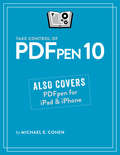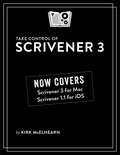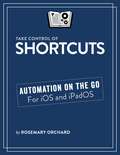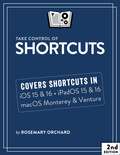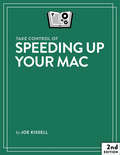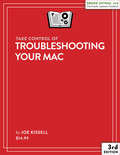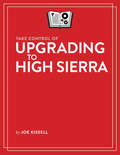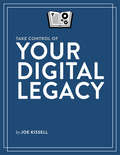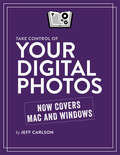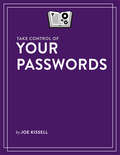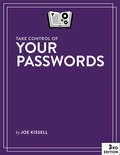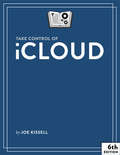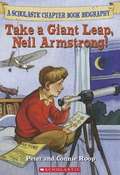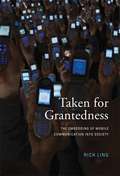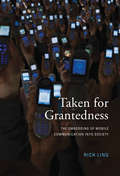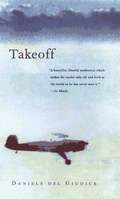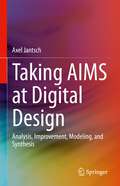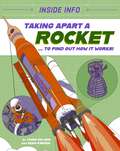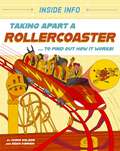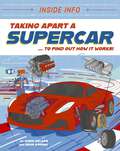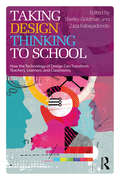- Table View
- List View
Take Control of PDFpen 10 (1.0)
by Michael E. CohenThis book tells you how create, edit, and enhance PDF documents on the Mac with Smile’s PDFpen 10 and PDFpenPro 10, and on the go with PDFpen for iPad and iPhone.
Take Control of Scrivener 3
by Kirk McElhearnLiterature & Latte’s Scrivener is an innovative app for writing fiction, non-fiction, screenplays, and other long-form texts. This book helps you start writing your masterpiece with Scrivener by showing you how to get the most out of the app’s basic concepts and features.
Take Control of Shortcuts
by Rosemary OrchardAutomation is no longer just for advanced Mac and PC users! Apple's Shortcuts app lets anyone with an iPhone or iPad automate day-to-day tasks, from the simple to the complex. This book is a complete introduction to Shortcuts, which covers every aspect of building, installing, debugging, running, syncing, and sharing shortcuts. It also includes step-by-step recipes for creating numerous useful shortcuts yourself.
Take Control of Shortcuts
by Rosemary OrchardAutomation is no longer just for advanced computer users! Apple's Shortcuts app lets anyone with an iPhone, iPad, or Mac automate day-to-day tasks, from the simple to the complex. This book is a complete introduction to Shortcuts, covering every aspect of building, installing, debugging, running, syncing, and sharing shortcuts. It also includes step-by-step recipes for creating numerous useful shortcuts yourself.
Take Control of Speeding Up Your Mac (2.0)
by Joe KissellDon’t settle for a sluggish Mac! If it seems your Mac has become slower and less responsive over time, it’s not your imagination—but it’s also a problem you can solve without buying a new computer. This comprehensive book teaches you how to find the exact causes of slow performance and take steps to make your Mac snappy again.
Take Control of Troubleshooting Your Mac (3.0)
by Joe KissellMacs are easy to use, but they can experience problems like any other machine. When something goes wrong with your Mac, use this book to figure out how to get back up and running. It teaches you basic troubleshooting steps, how to solve numerous common problems, and what to do if you encounter a novel problem with no apparent solution.
Take Control of Upgrading to High Sierra (1.1.2)
by Joe KissellUpgrading your Mac to a new operating system can be a daunting prospect, but with some expert advice, you’ll be running macOS 10.13 High Sierra in no time. This book eliminates the uncertainty and the confusion, guiding you through every step of the process.
Take Control of Your Digital Legacy
by Joe KissellPreserve your data for posterity!How do you want to be remembered by future generations? You can make a will to handle your physical possessions, but what about your digital life--photos, videos, email, documents, and the like? This ebook, written by tech expert Joe Kissell, covers many aspects of preserving such electronic ephemera as part of your digital legacy. If you're not at the stage of life where you can think about this for yourself, consider that you may have to do so for your parents or other relatives. It's not all about posterity either, since following Joe's advice will also help loved ones access your key accounts and important info if you're incapacitated, which can happen at any time. The book will help you with these essential tasks: Identify your key digital assets: online accounts, photos, audio files, videos, passwords, documents, email, and more. Plan for each type of digital asset based on your priorities for today, for shortly after you are no longer around, and for posterity. Joe explains the ideal file formats to use, how to deal with social media sites, the best ways to digitize paper documents and photos, and strategies for sharing passwords with family members, among much else. Communicate your wishes in a "digital will" and designate someone to be its "digital executor." The book includes a template document that you can develop into a personalized digital will. Preserve your data for the future. You'll consider types of archival storage media, cloud-based storage services, backups, and what instructions to provide about maintaining your data as file formats and storage media types evolve. Whether you just want to ensure that your heirs get copies of your favorite family photos and a few key documents or you want to catalog and preserve tens of thousands of digital items, this book helps you make smart decisions about your digital legacy. Questions answered include: What strategies can I use for sorting and preserving email? How can I ensure that my email account will be available to those wrapping up my estate? What if I have digital data that should be destroyed when I die? What should I do with my huge photo collection (both digital and paper)? How can I make my passwords available to those who will need them--but keep them private for now?What should I think about when handing down purchased audio and video files? What should happen to my Facebook account when I'm no longer around? What choices are available for keeping my digital archive available and backed up? How long should I expect archival media to last? Should I write an autobituary? Are online digital legacy services any good? How will organizing all this stuff benefit me while I'm alive?
Take Control of Your Digital Photos (1.0)
by Jeff CarlsonThis book gives photographers using Mac or Windows computers the information they need to build and maintain a digital photo workflow that makes it easy to import, tag, rate, and store photos to find them quickly and easily later. It primarily covers macOS 10.12 Sierra or later, Windows 10, and iOS 10 or later. It helps you spend more time on the enjoyable aspects of photography—shooting and viewing your photos—and less on the mundane but essential task of managing all your photos.
Take Control of Your Passwords
by Joe KissellPasswords are an irritating fact of modern life. It’s tricky to create and remember good ones, but dangerous to use simple ones (or reuse a password in multiple places). This book helps you overcome these problems with a sensible, stress-free strategy for password security.
Take Control of Your Passwords (3.0)
by Joe KissellPasswords are an irritating fact of modern life. It’s tricky to create and remember good ones, but dangerous to use simple ones (or reuse a password in multiple places). This book helps you overcome these problems with a sensible, stress-free strategy for password security.
Take Control of iCloud (6.0)
by Joe KisselliCloud is Apple’s suite of internet services. This book helps you make sense of iCloud, configure it for your needs, and choose the best ways of using each feature.
Take a Giant Leap, Neil Armstrong! (Before I Made History)
by Peter Roop Connie RoopScholastic Chapter Book, Biography of Neil Armstrong, the first man on the moon and what he was like as a young boy. <P><P>Lexile Measure: 720L
Taken for Grantedness
by Rich LingWhy do we feel insulted or exasperated when our friends and family don't answer their mobile phones? If the Internet has allowed us to broaden our social world into a virtual friend-net, the mobile phone is an instrument of a more intimate social sphere. The mobile phone provides a taken-for-granted link to the people to whom we are closest; when we are without it, social and domestic disarray may result. In just a few years, the mobile phone has become central to the functioning of society. In this book, Rich Ling explores the process by which the mobile phone has become embedded in society, comparing it to earlier technologies that changed the character of our social interaction and, along the way, became taken for granted. Ling, drawing on research, interviews, and quantitative material, shows how the mobile phone (and the clock and the automobile before it) can be regarded as a social mediation technology, with a critical mass of users, a supporting ideology, changes in the social ecology, and a web of mutual expectations regarding use. By examining the similarities and synergies among these three technologies, Ling sheds a more general light on how technical systems become embedded in society and how they support social interaction within the closest sphere of friends and family
Taken for Grantedness: The Embedding of Mobile Communication into Society (The\mit Press Ser.)
by Richard LingAn examination of how the mobile phone has become part of the fabric of society—as did such earlier technologies as the clock and the car.Why do we feel insulted or exasperated when our friends and family don't answer their mobile phones? If the Internet has allowed us to broaden our social world into a virtual friend-net, the mobile phone is an instrument of a more intimate social sphere. The mobile phone provides a taken-for-granted link to the people to whom we are closest; when we are without it, social and domestic disarray may result. In just a few years, the mobile phone has become central to the functioning of society. In this book, Rich Ling explores the process by which the mobile phone has become embedded in society, comparing it to earlier technologies that changed the character of our social interaction and, along the way, became taken for granted.Ling, drawing on research, interviews, and quantitative material, shows how the mobile phone (and the clock and the automobile before it) can be regarded as a social mediation technology, with a critical mass of users, a supporting ideology, changes in the social ecology, and a web of mutual expectations regarding use. By examining the similarities and synergies among these three technologies, Ling sheds a more general light on how technical systems become embedded in society and how they support social interaction within the closest sphere of friends and family.
Takeoff: The Pilot's Lore
by Daniele Del Giudice Joseph FarrellEight self-contained stories look insightfully at the delicacies of flying. Elegant ruminations about flying range from the dreamy to the concrete, from wartime to peacetime.
Taking AIMS at Digital Design: Analysis, Improvement, Modeling, and Synthesis
by Axel JantschThis is an introductory textbook for courses in Synchronous Digital Design that enables students to develop useful intuitions for all of the key concepts of digital design. The author focuses this tutorial on the design flow, which is introduced as an iterative cycle of Analysis, Improvement, Modeling, and Synthesis. All the basic elements of digital design are covered, starting with the CMOS transistor to provide an abstraction upon which everything else is built. The other main foundational concepts introduced are clocked synchronous register-transfer level design, datapath, finite state machines and communication between clock domains.
Taking Apart a Rocket: ... to find out how it works! (Inside Info #3)
by Chris OxladeFor any kid who's ever wanted to take a rocket apart to see how it works - this book invites you to slice, dice and delve into these amazing machines!Inside Info: Taking Apart a Rocket is a feast of facts, figures, diagrams and details with no layer unexplored. Pull apart all the rocket's stages, fuel tanks, engine parts, boosters, thrusters, exhaust systems, on-board controls, crew modules, escape systems, even space suits and splash-down parachutes! The Inside Info book series dives into the layers of things kids are curious about, exploring the science and tech through funky cross-sections, exploded diagrams, lots of labels, jokes and easter-egg details to discover. Written by experienced tech and science author Chris Oxlade, with fun and stylish art by Sean O'Brien, it's perfect for readers aged 7+.The series presents the Inside Info of: A Supercar, A Rocket, A Rollercoaster, A T. rex, The Human Body and A Coral Reef
Taking Apart a Rollercoaster: ... to find out how it works! (Inside Info #4)
by Chris OxladeFor any kid who's ever wanted to take a roller coaster apart to see how it works - this book invites you to slice, dice and delve into these amazing machines!Inside Info: Taking Apart a Roller Coaster is a feast of facts, figures, diagrams and details with no layer unexplored. Pull apart all the roller coaster's key parts: the tracks, cars, safety features, launch systems, wheels, supports, frames, safety bars, even the joints that allow the rides to twist and curl! The Inside Info book series dives into the layers of things kids are curious about, exploring the science and tech through funky cross-sections, exploded diagrams, lots of labels, jokes and easter-egg details to discover. Written by experienced tech and science author Chris Oxlade, with fun and stylish art by Sean O'Brien, it's perfect for readers aged 7+.The series presents the Inside Info of: A Supercar, A Rocket, A Rollercoaster, A T. rex, The Human Body and A Coral Reef
Taking Apart a Supercar: ... to find out how it works! (Inside Info #2)
by Chris OxladePeel back, take apart, reassemble and enjoy the awesome science of supercars!Inside Info: Taking Apart a Supercar is full of turbo-charged, sleek and surprising features of supercars of all kinds. Working inwards from the outermost layer - the streamlined spoilers and five layers of protective paint - to the heart of its power - the engine - we get to know the parts and process of making a supercar super. Finally, see how it all goes back together through the genius of production, engineering and design. Inside Info is a stylish and engrossing series of books diving into the layers of things kids are curious about - giving them the chance to pull it all apart and put it back together again, while learning STEM fundamentals! Perfect for readers aged 7 and up.The series presents the Inside Info of: Supercars, A Rocket, A Rollercoaster, A T. rex, The Human Body and A Coral Reef
Taking Design Thinking to School: How the Technology of Design Can Transform Teachers, Learners, and Classrooms
by Shelley Goldman Zaza KabayadondoDesign thinking is a method of problem-solving that relies on a complex set of skills, processes and mindsets that help people generate novel solutions to problems. Taking Design Thinking to School: How the Technology of Design Can Transform Teachers, Learners, and Classrooms uses an action-oriented approach to reframing K-12 teaching and learning, examining interventions that open up dialogue about when and where learning, growth, and empowerment can be triggered. While design thinking projects make engineering, design, and technology fluency more tangible and personal for a broad range of young learners, their embrace of ambiguity and failure as growth opportunities often clash with institutional values and structures. Through a series of in-depth case studies that honor and explore such tensions, the authors demonstrate that design thinking provides students with the agency and compassion that is necessary for doing creative and collaborative work, both in and out of the classroom. A vital resource for education researchers, practitioners, and policymakers, Taking Design Thinking to School brings together some of the most innovative work in design pedagogy.
Taking Flight: Education and Training for Aviation Careers
by Committee on Education Training for Civilian Aviation CareersThe commercial aviation industry is a major part of the U.S. transportation infrastructure and a key contributor to the nation's economy. The industry is facing the effects of a reduced role by the military as a source of high-quality trained personnel, particularly pilots and mechanics. At the same time, it is facing the challenges of a changing American workforce.This book is a study of the civilian training and education programs needed to satisfy the work-force requirements of the commercial aviation industry in the year 2000 and beyond, with particular emphasis on issues related to access to aviation careers by women and minorities.
Taking Flight: My Story
by Dan Gutman Vicki Van MeterThe autobiography of the young girl who learned to fly at age 10 and 2 years later piloted a plane across the Atlantic.
Taking Nazi Technology: Allied Exploitation of German Science after the Second World War
by Douglas M. O'ReaganIntriguing, real-life espionage stories bring to life a comparative history of the Allies' efforts to seize, control, and exploit German science and technology after the Second World War.During the Second World War, German science and technology posed a terrifying threat to the Allied nations. These advanced weapons, which included rockets, V-2 missiles, tanks, submarines, and jet airplanes, gave troubling credence to Nazi propaganda about forthcoming "wonder-weapons" that would turn the war decisively in favor of the Axis. After the war ended, the Allied powers raced to seize "intellectual reparations" from almost every field of industrial technology and academic science in occupied Germany. It was likely the largest-scale technology transfer in history.In Taking Nazi Technology, Douglas M. O'Reagan describes how the Western Allies gathered teams of experts to scour defeated Germany, seeking industrial secrets and the technical personnel who could explain them. Swarms of investigators invaded Germany's factories and research institutions, seizing or copying all kinds of documents, from patent applications to factory production data to science journals. They questioned, hired, and sometimes even kidnapped hundreds of scientists, engineers, and other technical personnel. They studied technologies from aeronautics to audiotapes, toy making to machine tools, chemicals to carpentry equipment. They took over academic libraries, jealously competed over chemists, and schemed to deny the fruits of German invention to any other land—including that of other Allied nations. Drawing on declassified records, O'Reagan looks at which techniques worked for these very different nations, as well as which failed—and why. Most importantly, he shows why securing this technology, how the Allies did it, and when still matters today. He also argues that these programs did far more than spread German industrial science: they forced businessmen and policymakers around the world to rethink how science and technology fit into diplomacy, business, and society itself.
Taking Off Domestic Building Construction: An Introduction to Building Quantities
by Andrew AtkinsonThis book provides a detailed step-by-step guide to taking off building work. It is pitched at a basic introductory level especially suitable for technicians entering the construction industry from school, perhaps intending to follow a trade or technical career. An ideal workbook for students of quantity surveying, construction and civil engineering when learning to measure building work. It introduces students to the most basic aspects of measurement and prepares them for learning the more complex areas of taking off. The book works through examples based on the measurement of a simple traditional pair of semi-detached (duplex) houses, with the relevant construction technology explained throughout. Although the format largely follows United Kingdom taking-off practice and conventions, it will be directly applicable to international practice in countries broadly following United Kingdom conventions. Each chapter presents a worked example from the substructure, through to masonry walls, upper floors, roofing, internal finishes, windows and doors. The examples are matched to an exercise for students and include a commentary of why and how the take-off work is being done. Concentrating specifically on the skilled task of taking off, the examples are designed to give confidence and practice rather than theoretical knowledge. This practical book is ideal for use on the Design, Surveying and Planning T Level; HNC Construction; and undergraduate and non-cognate postgraduate courses in Quantity Surveying, Construction and Building Surveying.
